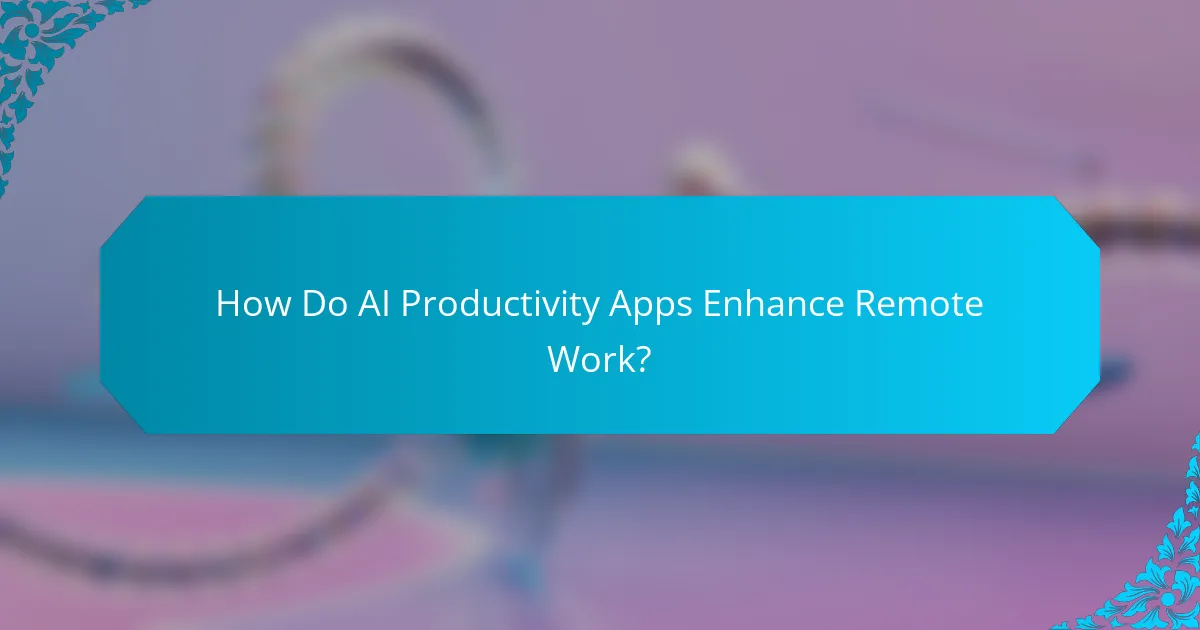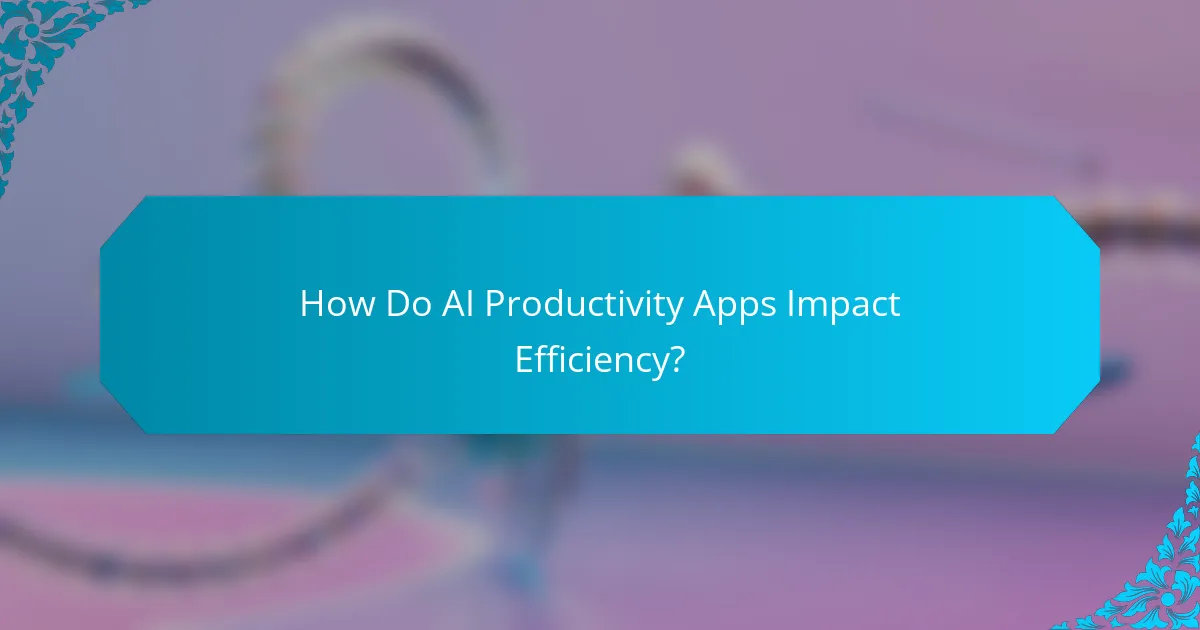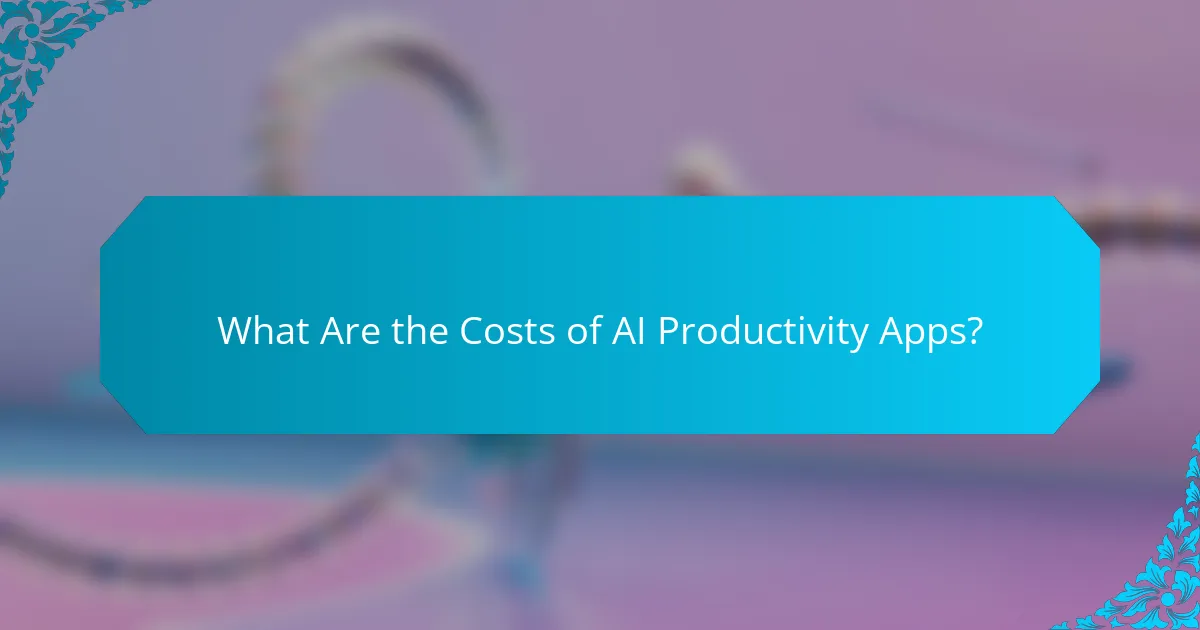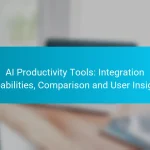AI productivity apps are transforming the way we approach time tracking and remote work by offering innovative solutions that enhance efficiency. These applications utilize artificial intelligence to automate tasks, monitor work hours, and provide valuable insights into productivity patterns, making it easier for teams to collaborate and manage their time effectively. When choosing the right tools, consider features that streamline processes and improve overall performance.
![]()
What Are the Best AI Productivity Apps for Time Tracking?
The best AI productivity apps for time tracking help users monitor their work hours efficiently, providing insights into productivity patterns. These tools often utilize artificial intelligence to automate tracking and reporting, making it easier to manage time effectively.
Toggl Track
Toggl Track is a user-friendly time tracking tool that allows individuals and teams to log hours effortlessly. It offers features like one-click time tracking, project management, and reporting capabilities, making it suitable for freelancers and businesses alike.
With Toggl Track, users can categorize their time entries by projects or clients, which helps in analyzing productivity. The app also integrates with various project management tools, enhancing its functionality for remote work environments.
Clockify
Clockify is a free time tracking software that provides a comprehensive solution for monitoring work hours. It allows users to track time manually or automatically, making it versatile for different work styles.
This app features reporting tools that help visualize productivity trends, and it supports team collaboration by allowing multiple users to log hours on shared projects. Clockify is particularly beneficial for teams looking to manage billable hours effectively.
Harvest
Harvest is a time tracking and invoicing tool designed for businesses that need to manage projects and budgets. It allows users to track time spent on tasks and generate invoices based on logged hours, streamlining the billing process.
Harvest integrates with various project management applications, making it easy to sync time entries with ongoing projects. Its reporting features provide insights into team performance and project profitability, which can be crucial for decision-making.
RescueTime
RescueTime focuses on providing insights into how users spend their time on digital devices. It runs in the background, automatically tracking time spent on applications and websites, which helps identify productivity patterns.
This app offers detailed reports and alerts to help users stay focused on their goals. By understanding where time is lost, users can make informed adjustments to their work habits, enhancing overall efficiency.
Timely
Timely is an AI-powered time tracking app that automatically records time spent on tasks without manual input. It uses machine learning to categorize activities and generate reports, making time tracking seamless.
Timely’s unique feature is its visual timeline, which allows users to see their day at a glance. This can help in planning future tasks and ensuring that time is allocated effectively across projects.

How Do AI Productivity Apps Enhance Remote Work?
AI productivity apps significantly enhance remote work by streamlining communication, automating repetitive tasks, and providing insights into team performance. These tools leverage artificial intelligence to improve efficiency, making it easier for remote teams to collaborate effectively and manage their time.
Improved Collaboration
AI productivity apps facilitate improved collaboration by offering features like real-time messaging, video conferencing, and shared document editing. Tools such as Slack or Microsoft Teams enable team members to communicate instantly, regardless of their location.
Additionally, these apps often integrate with project management software, allowing teams to track progress and share updates seamlessly. This integration helps prevent miscommunication and ensures everyone is on the same page, which is crucial for remote work success.
Task Automation
Task automation is a key feature of AI productivity apps that saves time and reduces manual effort. By automating repetitive tasks such as scheduling meetings or sending reminders, these tools free up employees to focus on more strategic activities.
For instance, tools like Zapier can connect different applications to automate workflows, such as automatically updating a project management tool when a task is completed. This not only increases efficiency but also minimizes the risk of human error.
Real-time Analytics
Real-time analytics provided by AI productivity apps help teams monitor their performance and make data-driven decisions. These insights can include metrics on time spent on tasks, project progress, and team engagement levels.
Using analytics tools like Trello or Asana, managers can identify bottlenecks and areas for improvement. This allows for timely adjustments to workflows, ensuring that remote teams remain productive and aligned with their goals.

What Features Should You Look for in AI Productivity Apps?
When selecting AI productivity apps, focus on features that enhance time tracking, streamline remote work, and boost overall efficiency. Key aspects include integration capabilities, user-friendly interfaces, and robust reporting tools that provide insights into productivity trends.
Integration Capabilities
Integration capabilities are crucial for AI productivity apps as they allow seamless connection with other tools and platforms. Look for apps that can easily sync with popular project management software, calendars, and communication tools like Slack or Microsoft Teams.
Consider whether the app supports APIs or has built-in integrations with third-party services. This can significantly reduce manual data entry and improve workflow efficiency, enabling teams to work more cohesively.
User Interface
A user-friendly interface is essential for maximizing the effectiveness of AI productivity apps. The design should be intuitive, allowing users to navigate easily without extensive training. A clean layout with clear icons and simple menus enhances user experience.
Look for customizable dashboards that let users prioritize tasks and view relevant metrics at a glance. A responsive design that works well on both desktop and mobile devices is also important for remote work flexibility.
Reporting Tools
Robust reporting tools are vital for tracking productivity and identifying areas for improvement. Effective AI productivity apps should offer customizable reports that can display time spent on tasks, project progress, and team performance metrics.
Consider apps that provide visual data representations, such as graphs and charts, to make insights easier to digest. Regular reporting features can help teams adjust strategies and enhance overall efficiency, ensuring that goals are met consistently.

How Do AI Productivity Apps Impact Efficiency?
AI productivity apps significantly enhance efficiency by automating routine tasks, streamlining workflows, and providing insights into performance. These tools help individuals and teams manage their time better, focus on critical tasks, and allocate resources effectively.
Time Savings
AI productivity apps can save users substantial time by automating repetitive tasks such as scheduling, data entry, and reminders. For instance, tools like calendar assistants can handle meeting arrangements, freeing up hours each week.
Additionally, these applications often analyze user habits to suggest optimal work schedules, potentially reducing time spent on less productive activities. Users may find they can reclaim up to 20-30% of their work hours with effective time-saving features.
Focus Enhancement
AI productivity apps improve focus by minimizing distractions and helping users prioritize tasks. Features like distraction blockers and focus timers encourage users to concentrate on one task at a time, which can lead to better outcomes.
For example, apps that use the Pomodoro technique can help maintain focus by breaking work into intervals, typically 25 minutes long, followed by short breaks. This method can enhance productivity and reduce burnout.
Resource Management
Effective resource management is another key benefit of AI productivity apps, as they provide insights into how time and resources are allocated. Users can track project progress and identify bottlenecks, enabling better decision-making.
For instance, project management tools can visualize workloads and deadlines, allowing teams to redistribute tasks based on current capacity. This proactive approach can lead to more balanced workloads and improved team performance.

What Are the Costs of AI Productivity Apps?
The costs of AI productivity apps can vary significantly based on features, subscription models, and user needs. Users should consider both direct costs, such as monthly fees, and indirect costs, like time spent learning to use the app effectively.
Subscription Models
AI productivity apps typically offer various subscription models, including monthly, annual, and pay-as-you-go options. Monthly subscriptions provide flexibility, while annual plans often come with discounts, making them more cost-effective for long-term users.
When choosing a subscription model, consider your usage frequency and the specific features you need. For instance, some apps may charge extra for advanced features like analytics or integrations with other tools, which can increase overall costs.
It’s advisable to take advantage of free trials or freemium versions to assess the app’s value before committing to a paid plan. This approach helps avoid unnecessary expenses and ensures the app meets your productivity needs.
